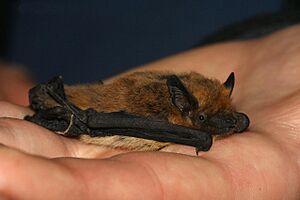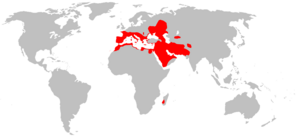Kuhl's pipistrelle facts for kids
Quick facts for kids Kuhl's pipistrelle |
|
|---|---|
 |
|
| Conservation status | |
| Scientific classification | |
| Genus: |
Pipistrellus
|
| Species: |
kuhlii
|
 |
|
| Global range of P. kuhlii (red) | |
| Synonyms | |
|
Vespertilio kuhlii Kuhl, 1817 |
|
The Kuhl's pipistrelle (Pipistrellus kuhlii) is a small bat species. It lives in many parts of North Africa, Southern Europe, and West Asia. These bats can be found in different places. They live in temperate forests, dry shrublands, and areas with Mediterranean plants. You can also find them in grasslands, gardens, and even cities.
Kuhl's pipistrelles are not often seen in Britain. They are usually only found there through sound recordings. A special bat specimen is kept at the Palestine Museum of Natural History. It is the first time this bat was found "caught by a plant in the Arab world."
Contents
About Kuhl's Pipistrelle
Kuhl's pipistrelle is a type of vesper bat. Vesper bats are the largest family of bats. They are found all over the world. These bats are usually small to medium-sized. They have plain faces and small eyes.
Where Kuhl's Pipistrelle Lives
This bat species lives in many different habitats. It can be found in forests where the weather is mild. It also lives in dry, bushy areas. These areas often have plants that are used to dry summers. Kuhl's pipistrelles also live in open grasslands. They are known to live near people too. You might find them in rural gardens or even busy urban areas.
How Kuhl's Pipistrelle Got Its Name
Scientists first officially named Kuhl's pipistrelle in 1817. It was first called Vespertilio kuhlii. This name was given in a book by Heinrich Kuhl. The book was about the bats of Germany. The bat was named after Kuhl himself. This was done to honor him.
For a while, bats from Algeria, Egypt, Libya, and Sudan were thought to be a different species. They were called Pipistrellus deserti. But scientists later found out they were the same species. So, Pipistrellus deserti is now just another name for Kuhl's pipistrelle.
Conservation Status
The Kuhl's pipistrelle is listed as "Least Concern" (LC) by the IUCN. This means that the species is widespread. It is not currently at risk of disappearing. Its population is stable in many areas.
Images for kids



